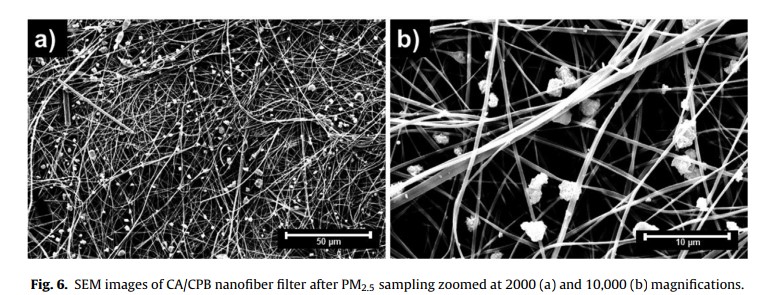© Copyright 2020 Foshan Membrane Technology Co., Ltd. All rights reserved. Sitemap
The increase of the industrialization process brought the growth of pollutant emissions into the atmosphere. At the same time, the demand for advances in aerosol filtration is evolving towards more sustainable technologies. Electrospinning is gaining notoriety, once it enables to produce polymeric nanofibers with different additives and also the obtaining of small pore sizes and fiber diameters; desirable features for air filtration materials. Therefore, this work aims to evaluate the filtration performance of cellulose acetate (CA) nanofibers and cationic surfactant cetylpyridinium bromide (CPB) produced by electrospinning technique for retention of aerosol nanoparticles. The pressure drop and collection efficiency measurements of sodium chloride (NaCl) aerosol particles (diameters from 7 to 300 nm) were performed using Scanning Mobility Particle Sizer (SMPS). The average diameter of the electrospun nanofibers used was 239 nm, ranging from 113 to 398 nm. Experimental results indicated that the nanofibers showed good permeability (10(-11) m(2)) and high-efficiency filtration for aerosol nanoparticles (about 100 %), which can include black carbon (BC) and the new coronavirus. The pressure drop was 1.8 kPa at 1.6 cm s(-1), which is similar to reported for some high-efficiency nanofiber filters. In addition, it also retains BC particles present in air, which was about 90 % for 375 nm and about 60 % for the 880 nm wavelength. Finally, this research provided information for future designs of indoor air filters and filter media for facial masks with renewable, non-toxic biodegradable, and potential antibacterial characteristics. (C) 2020 Institution of Chemical Engineers. Published by Elsevier B.V. All rights reserved.
工业化进程的增加使污染物排放量愈加严重。同时,对气雾过滤技术进步的需求正在向更可持续的技术发展。一旦静电纺丝技术能够生产具有不同添加剂的聚合物纳米纤维,并且能够获得较小的孔径和纤维直径,静电纺丝技术将广为人知。空气过滤材料的理想特性。因此,这项工作旨在评估醋酸纤维素(CA)纳米纤维和阳离子表面活性剂十六烷基溴化十六烷基吡啶溴化物(CPB)的过滤性能,这些阳离子表面活性剂是通过电纺丝技术保留气溶胶纳米颗粒而制成的。使用扫描移动粒度仪(SMPS)对氯化钠(NaCl)气溶胶颗粒(直径从7到300 nm)进行压降和收集效率测量。所使用的电纺纳米纤维的平均直径为239 nm,范围为113至398 nm。实验结果表明,纳米纤维表现出良好的渗透性(10(-11)m(2))和高效过滤的气溶胶纳米颗粒(约100%),其中可以包括黑碳(BC)和新的冠状病毒。在1.6 cm s(-1)处的压降为1.8 kPa,这与某些高效纳米纤维过滤器的报道相似。另外,它还保留了存在于空气中的BC颗粒,这对于375 nm约为90%,对于880 nm波长约为60%。最后,这项研究为室内空气过滤器和面膜过滤介质的未来设计提供了信息,这些面罩具有可再生,无毒可生物降解和潜在的抗菌特性。 (C)2020化学工程师协会。由Elsevier B.V.出版,保留所有权利。

Published: 2020
Journal :PROCESS SAFETY AND ENVIRONMENTAL PROTECTION
Impact Factor:5.644
Paper link: https://www.sciencedirect.com/science/article/abs/pii/S0957582020316323